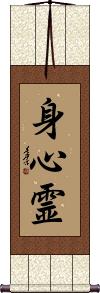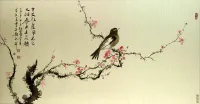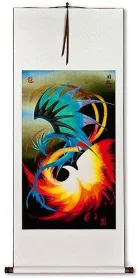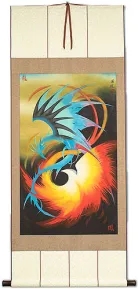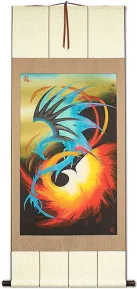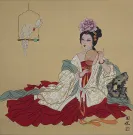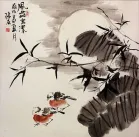Many custom options...
And formats...

The name Mental and Physical in Chinese / Japanese...
Buy a Mental and Physical calligraphy wall scroll here!
Personalize your custom “Mental and Physical” project by clicking the button next to your favorite “Mental and Physical” title below...
Body and Mind
身心 means “body and mind” or “mental and physical” in Chinese and Japanese.
In the Buddhist context, body and mind encompass the five elements (skandha) of a sentient being.
The body is the physical material (rūpa) of life. The mind embraces the other four skandhas, which are consciousness, perception, action, and knowledge.
Body Mind Spirit
身心霊 means “body mind spirit” in Japanese.
This refers to your physical, mental, and spiritual presence.
This can also be translated as “body heart spirit” as 心 can mean mind or heart.
Note that this is a "word list" and not a proper phrase (with a subject, verb, and object) nor a typical title in Japanese. So it's not too commonly seen in Japan. However, the term 身心霊整合性医療 that refers to holistic medicine is gaining popularity.
This in-stock artwork might be what you are looking for, and ships right away...
Gallery Price: $322.00
Your Price: $178.88
Not the results for mental and physical that you were looking for?
Below are some entries from our dictionary that may match your mental and physical search...
| Characters If shown, 2nd row is Simp. Chinese |
Pronunciation Romanization |
Simple Dictionary Definition |
五果 see styles |
wǔ guǒ wu3 guo3 wu kuo goka ごか |
(1) five fruits (peach, Japanese plum, apricot, jujube, Japanese chestnut); (2) (Buddhist term) five types of effect in cause-and-effect relationships; (3) (Buddhist term) five effects of ignorance and formations on one's current life The five fruits, or effects; there are various groups, e. g. I. (1) 異熟果 fruit ripening divergently, e. g. pleasure and goodness are in different categories; present organs accord in pain or pleasure with their past good or evil deeds; (2) 等流果 fruit of the same order, e. g. goodness reborn from previous goodness; (3) 土用果 present position and function fruit, the rewards of moral merit in previous lives; (4) 增上果 superior fruit, or position arising from previous earnest endeavor and superior capacity: (5) 離繋果 fruit of freedom from all bonds, nirvana fruit. II. Fruit, or rebirth: (1) 識 conception (viewed psychologically); (2) 名色 formation mental and physical; (3) 六處 the six organs of perception complete; (4) 觸 their birth and contact with the world; (5) 受 consciousness. III. Five orders of fruit, with stones, pips, shells (as nuts), chaff-like (as pine seeds), and with pods. |
除覺支 除觉支 see styles |
chú jué zhī chu2 jue2 zhi1 ch`u chüeh chih chu chüeh chih jo kakushi |
To get rid of mental effort and produce mental and physical buoyancy. |
身心 see styles |
shēn xīn shen1 xin1 shen hsin shinshin しんじん |
More info & calligraphy: Body and Mind(noun - becomes adjective with の) mind and body Body and mind, the direct fruit of the previous life. The body is rūpa, the first skandha; mind embraces the other four, consciousness, perception, action, and knowledge; v. 五蘊. |
心力 see styles |
xīn lì xin1 li4 hsin li shinriki |
mental and physical efforts mental power |
魂魄 see styles |
hún pò hun2 po4 hun p`o hun po konpaku こんぱく |
More info & calligraphy: Ghost / Soul / Spiritsoul; spirit; ghost Animus and anima; the spiritual nature or mind, and the animal soul; the two are defined as mind and body or mental and physical, the invisible soul inhabiting the visible body, the former being celestial, the latter terrestrial. |
五苦 see styles |
wǔ kǔ wu3 ku3 wu k`u wu ku goku |
The five forms of suffering: I. (1) Birth, age, sickness, death; (2) parting with those loved; (3) meeting with the hated or disliked; (4) inability to obtain the desired; (5) the five skandha sufferings, mental and physical. II. Birth, age, sickness, death, and the shackles (for criminals). III. The sufferings of the hells, and as hungry ghosts, animals, asuras, and human beings. |
五盛陰苦 五盛阴苦 see styles |
wǔ shèng yīn kǔ wu3 sheng4 yin1 ku3 wu sheng yin k`u wu sheng yin ku gosei in ku |
The mental and physical sufferings arising from the full-orbed activities of the skandhas 五陰, one of the eight sufferings; also 五陰盛 (五陰盛苦). |
心 see styles |
xīn xin1 hsin shin しん |
More info & calligraphy: Heart / Mind / Spirit(1) (See 心・こころ・1) heart; mind; spirit; vitality; inner strength; (2) bottom of one's heart; core (of one's character); nature; (3) (usu. written as 芯) (See 芯・2) centre; center; core; heart; (4) (See 心臓・1) heart (organ); (5) {astron} (See 二十八宿) Chinese "Heart" constellation (one of the 28 mansions); (6) (archaism) (child. language) friend; (given name) Haato hṛd, hṛdaya 汗栗太 (or 汗栗馱); 紀哩馱 the heart, mind, soul; citta 質多 the heart as the seat of thought or intelligence. In both senses the heart is likened to a lotus. There are various definitions, of which the following are six instances: (1) 肉團心 hṛd, the physical heart of sentient or nonsentient living beings, e. g. men, trees, etc. (2) 集起心 citta, the ālayavijñāna, or totality of mind, and the source of all mental activity. (3) 思量心 manas, the thinking and calculating mind; (4) 緣慮心; 了別心; 慮知心; citta; the discriminating mind; (5) 堅實心 the bhūtatathatā mind, or the permanent mind; (6) 積聚精要心 the mind essence of the sutras. |
安穩 安稳 see styles |
ān wěn an1 wen3 an wen an non |
More info & calligraphy: Stable - Mind at Peace安隱 Body and mind at rest. |
受 see styles |
shòu shou4 shou ju じゅ |
to receive; to accept; to suffer; subjected to; to bear; to stand; pleasant; (passive marker); (LGBT) bottom {Buddh} (See 五蘊,十二因縁) vedana (sensation); (place-name) Uke To receive, be, bear; intp. of vedana, 'perception,' 'knowledge obtained by the senses, feeling, sensation.' M. W. It is defined as mental reaction to the object, but in general it means receptivity, or sensation; the two forms of sensation of physical and mental objects are indicated. It is one of the five skandhas; as one of the twelve nidānas it indicates the incipient stage of sensation in the embryo. |
有 see styles |
yǒu you3 yu yuu / yu ゆう |
to have; there is; (bound form) having; with; -ful; -ed; -al (as in 有意[you3 yi4] intentional) (1) existence; (n,n-pref) (2) possession; having; (3) (abbreviation) (in company names; written as (有)) (See 有限会社) limited company; (personal name) Yumi bhāva: that which exists, the existing, existence; to have, possess, be. It is defined as (1) the opposite of 無 wu and 空 kong the non-existent; (2) one of the twelve nidānas, existence; the condition which, considered as cause, produces effect; (3) effect, the consequence of cause; (4) anything that can be relied upon in the visible or invisible realm. It means any state which lies between birth and death, or beginning and end. There are numerous categories— 3, 4, 7, 9, 18, 25, and 29. The 三有 are the 三界 trailokya, i. e. 欲, 色 and 無色界 the realms of desire, of form, and of non-form, all of them realms of mortality; another three are 本有 the present body and mind, or existence, 當有 the future ditto, 中有 the intermediate ditto. Other definitions give the different forms or modes of existence. |
苦 see styles |
kǔ ku3 k`u ku ku く |
bitter; hardship; pain; to suffer; to bring suffering to; painstakingly (1) pain; anguish; suffering; distress; anxiety; worry; trouble; difficulty; hardship; (2) {Buddh} (See 八苦) duhkha (suffering) duḥkha, 豆佉 bitterness; unhappiness, suffering, pain, distress, misery; difficulty. There are lists of two, three, four, five, eight, and ten categories; the two are internal, i. e. physical and mental, and external, i. e. attacks from without. The four are birth, growing old, illness, and death. The eight are these four along with the pain of parting from the loved, of meeting with the hated, of failure in one's aims, and that caused by the five skandhas; cf. 四諦. |
蘊 蕴 see styles |
yùn yun4 yün osamu おさむ |
to accumulate; to hold in store; to contain; to gather together; to collect; depth; inner strength; profundity (given name) Osamu skandha, v. 塞; older tr. 陰, intp. as that which covers or conceals, implying that physical and mental forms obstruct realization of the truth; while the tr. 蘊, implying an accumulation or heap, is a nearer connotation to skandha, which, originally meaning the shoulder, becomes stem, branch, combination, the objects of sense, the elements of being or mundane consciousness. The term is intp. as the five physical and mental constituents, which combine to form the intelligent 性 or nature; rūpa, the first of the five, is considered as physical, the remaining four as mental; v. 五蘊. The skandhas refer only to the phenomenal, not to the 無爲 non-phenomenal. |
護 护 see styles |
hù hu4 hu mori もり |
to protect (surname) Mori To protect, guard, succour.; The two protectors: the inner, oneself, by studying and following the Law; the outer, those who supply what is needful for one's body and mind, e. g. supporters. |
三有 see styles |
sān yǒu san1 you3 san yu san'u |
The three kinds of bhava, or existence; idem 三界 q. v. The three states of mortal existence in the trailokya, i. e. in the realms of desire, of form, and beyond form. Another definition is 現有 present existence, or the present body and mind; 當有 in a future state; 中有 antara-bhava, in the intermediate state. 三有對 The three sets of limitation on freedom: (a) direct resistance or opposition; (b) environment or condition; (c) attachment. 三有爲法 The three active) functioning dharmas: (1) pratigha, matter or form, i. e. that which has ' substantial resistance'; (2) mind; and (3) 非色非心 entities neither of matter nor mind; cf. 七十五法. 三有爲相 The three forms of all phenomena, birth, stay (i. e. 1ife), death; utpāda, sthiti, and nirvana. |
二受 see styles |
èr shòu er4 shou4 erh shou niju |
The dual receptivity or karma of pleasure and pain, the physical and the mental, i.e. 身 and 心. |
二忍 see styles |
èr rěn er4 ren3 erh jen ninin |
The two patiences or endurances: 衆生忍 patience towards all under all circumstances; 無生(法)忍 calm rest, as a bodhisattva、in the assurance of no (re-) birth, i.e. in immortality. Also 安受苦忍 patience under suffering, and 觀察法忍 imperturbable examination of or meditation in the law or of all things. Also, physical and mental patience, or endurance. |
五蘊 五蕴 see styles |
wǔ yùn wu3 yun4 wu yün goun / gon ごうん |
the Five Aggregates (from Sanskrit "skandha") (Buddhism) {Buddh} the five skandhas (matter, sensation, perception, mental formations and consciousness); the five aggregates The five skandhas, pañca-skandha: also 五陰; 五衆; 五塞犍陀 The five cumulations, substances, or aggregates, i. e. the components of an intelligent being, specially a human being: (1) 色 rūpa, form, matter, the physical form related to the five organs of sense; (2) 受 vedana, reception, sensation, feeling, the functioning of the mind or senses in connection with affairs and things; (3) 想 saṃjñā, conception, or discerning; the functioning of mind in distinguishing; (4) 行 saṃskāra, the functioning of mind in its processes regarding like and dislike, good and evil, etc.; (5) 識 vijñāna, mental faculty in regard to perception and cognition, discriminative of affairs and things. The first is said to be physical, the other four mental qualities; (2), (3), and (4) are associated with mental functioning, and therefore with 心所; (5) is associated with the faculty or nature of the mind 心王 manas. Eitel gives— form, perception, consciousness, action, knowledge. See also Keith's Buddhist Philosophy, 85-91. |
六入 see styles |
liù rù liu4 ru4 liu ju rokunyuu / rokunyu ろくにゅう |
{Buddh} six sense organs (eyes, ears, nose, tongue, body, and mind) ṣaḍāyatana; 六阿耶怛那 (or 六阿也怛那) the six entrances, or locations, both the organ and the sensation — eye, ear, nose, tongue, body, and mind; sight, hearing, smell, taste, touch, and perception. The six form one of the twelve nidanas, see 十二因緣. The 六根 are the six organs, the 六境 the six objects, and the 六塵 or guṇas, the six inherent qualities. The later term is 六處 q. v.; The "six entries" ṣaḍāyatana, which form one of the links in the chain of causaton, v. 十二因緣 the preceding link being觸contact, and the succeeding link 識 perception. The six are the qualities and effects of the six organs of sense producing sight, hearing, smell, taste, touch, and thought (or mental presentations). v. also 二入. |
六処 see styles |
rokusho ろくしょ |
{Buddh} six sense organs (eyes, ears, nose, tongue, body, and mind) |
六境 see styles |
liù jìng liu4 jing4 liu ching rokkyou / rokkyo ろっきょう |
{Buddh} six objective fields of the senses (shape and colour, sound, scent, flavour, physical feeling, and mental presentation) The six fields of the senses, i. e. the objective fields of sight, sound, smell, taste, touch, and idea (or thought); rūpa, form and color, is the field of vision; sound, of hearing; scent, of smelling; the five flavors, of tasting; physical feeling, of touch; and mental presentation, of discernment; cf. 六入; 六處 and next. |
六根 see styles |
liù gēn liu4 gen1 liu ken rokkon ろっこん |
{Buddh} six sense organs (eyes, ears, nose, tongue, body, and mind); (surname) Rokkon The six indriyas or sense-organs: eye, ear, nose, tongue, body, and mind. See also 六入, 六境, 六塵, and 六處. |
安神 see styles |
ān shén an1 shen2 an shen yasukami やすかみ |
to calm (soothe) the nerves; to relieve uneasiness of body and mind (adj-na,n,vs) relief; peace of mind; (surname) Yasukami |
小乘 see styles |
xiǎo shèng xiao3 sheng4 hsiao sheng shōjō |
Hinayana, the Lesser Vehicle; Buddhism in India before the Mayahana sutras; also pr. [Xiao3 cheng2] Hīnayāna 希那衍. The small, or inferior wain, or vehicle; the form of Buddhism which developed after Śākyamuni's death to about the beginning of the Christian era, when Mahāyāna doctrines were introduced. It is the orthodox school and more in direct line with the Buddhist succession than Mahāyānism which developed on lines fundamentally different. The Buddha was a spiritual doctor, less interested in philosophy than in the remedy for human misery and perpetual transmigration. He "turned aside from idle metaphysical speculations; if he held views on such topics, he deemed them valueless for the purposes of salvation, which was his goal" (Keith). Metaphysical speculations arose after his death, and naturally developed into a variety of Hīnayāna schools before and after the separation of a distinct school of Mahāyāna. Hīnayāna remains the form in Ceylon, Burma, and Siam, hence is known as Southern Buddhism in contrast with Northern Buddhism or Mahāyāna, the form chiefly prevalent from Nepal to Japan. Another rough division is that of Pali and Sanskrit, Pali being the general literary language of the surviving form of Hīnayāna, Sanskrit of Mahāyāna. The term Hīnayāna is of Mahāyānist origination to emphasize the universalism and altruism of Mahāyāna over the narrower personal salvation of its rival. According to Mahāyāna teaching its own aim is universal Buddhahood, which means the utmost development of wisdom and the perfect transformation of all the living in the future state; it declares that Hīnayāna, aiming at arhatship and pratyekabuddhahood, seeks the destruction of body and mind and extinction in nirvāṇa. For arhatship the 四諦Four Noble Truths are the foundation teaching, for pratyekabuddhahood the 十二因緣 twelve-nidānas, and these two are therefore sometimes styled the two vehicles 二乘. Tiantai sometimes calls them the (Hīnayāna) Tripiṭaka school. Three of the eighteen Hīnayāna schools were transported to China: 倶舍 (Abhidharma) Kośa; 成實 Satya-siddhi; and the school of Harivarman, the律 Vinaya school. These are described by Mahāyānists as the Buddha's adaptable way of meeting the questions and capacity of his hearers, though his own mind is spoken of as always being in the absolute Mahāyāna all-embracing realm. Such is the Mahāyāna view of Hīnayāna, and if the Vaipulya sūtras and special scriptures of their school, which are repudiated by Hīnayāna, are apocryphal, of which there seems no doubt, then Mahāyāna in condemning Hīnayāna must find other support for its claim to orthodoxy. The sūtras on which it chiefly relies, as regards the Buddha, have no authenticity; while those of Hīnayāna cannot be accepted as his veritable teaching in the absence of fundamental research. Hīnayāna is said to have first been divided into minority and majority sections immediately after the death of Śākyamuni, when the sthāvira, or older disciples, remained in what is spoken of as "the cave", some place at Rājagṛha, to settle the future of the order, and the general body of disciples remained outside; these two are the first 上坐部 and 大衆部 q. v. The first doctrinal division is reported to have taken place under the leadership of the monk 大天 Mahādeva (q.v.) a hundred years after the Buddha's nirvāṇa and during the reign of Aśoka; his reign, however, has been placed later than this by historians. Mahādeva's sect became the Mahāsāṅghikā, the other the Sthāvira. In time the two are said to have divided into eighteen, which with the two originals are the so-called "twenty sects" of Hīnayāna. Another division of four sects, referred to by Yijing, is that of the 大衆部 (Arya) Mahāsaṅghanikāya, 上座部 Āryasthavirāḥ, 根本說一切有部 Mūlasarvāstivādaḥ, and 正量部 Saṃmatīyāḥ. There is still another division of five sects, 五部律. For the eighteen Hīnayāna sects see 小乘十八部. |
幻垢 see styles |
huàn gòu huan4 gou4 huan kou genku |
Illusory and defiled, i. e. body and mind are alike illusion and unclean. |
心法 see styles |
xīn fǎ xin1 fa3 hsin fa shinpou / shinpo しんぽう |
(surname) Shinpou Mental dharmas, idea— all 'things' are divided into two classes 色 and 心 physical and mental; that which has 質礙 substance and resistance is physical, that which is devoid of these is mental; or the root of all phenomena is mind 緣起諸法之根本者爲心法. The exoteric and esoteric schools differ in their interpretation: the exoterics hold that mental ideas or 'things' are 無色無形 unsubstantial and invisible, the esoterics that they 有色有形 have both substance and form. |
正報 正报 see styles |
zhèng bào zheng4 bao4 cheng pao shouhou / shoho しょうほう |
{Buddh} (See 依報) direct retribution; body and mind one is born into because of karma in previous lives; (given name) Seihou The direct retribution of the individual's previous existence, such as being born as a man, etc. Also 正果. |
法相 see styles |
fǎ xiàng fa3 xiang4 fa hsiang hossou / hosso ほっそう |
(1) {Buddh} (See 法性) dharmalaksana (dharma characteristics, the specific characteristics of all manifest phenomena); (2) (abbreviation) (See 法相宗) Hosso sect of Buddhism The aspects of characteristics of things-all things are of monad nature but differ in form. A name of the 法相宗 Faxiang or Dharmalakṣaṇa sect (Jap. Hossō), called also 慈恩宗 Cien sect from the Tang temple, in which lived 窺基 Kuiji, known also as 慈恩. It "aims at discovering the ultimate entity of cosmic existence n contemplation, through investigation into the specific characteristics (the marks or criteria) of all existence, and through the realization of the fundamental nature of the soul in mystic illumination". "An inexhaustible number" of "seeds" are "stored up in the Ālaya-soul; they manifest themselves in innumerable varieties of existence, both physical and mental". "Though there are infinite varieties. . . they all participate in the prime nature of the ālaya." Anesaki. The Faxiang School is one of the "eight schools", and was established in China on the return of Xuanzang, consequent on his translation of the Yogācārya works. Its aim is to understand the principle underlying the 萬法性相 or nature and characteristics of all things. Its foundation works are the 解深密經, the 唯識論, and the 瑜伽論. It is one of the Mahāyāna realistic schools, opposed by the idealistic schools, e.g. the 三論 school; yet it was a "combination of realism and idealism, and its religion a profoundly mystic one". Anesaki. |
百法 see styles |
bǎi fǎ bai3 fa3 pai fa hyappō |
The hundred divisions of all mental qualities and their agents, of the 唯識 School; also known as the 五位百法five groups of the 100 modes or 'things': (1) 心法 the eight 識 perceptions, or forms of consciousness; (2) 心所有法 the fifty-one mental ideas; (3) 色法 the five physical organs and their six modes of sense, e. g. ear and sound; (4) 不相應行 twenty-four indefinites, or unconditioned elements; (5) 無爲 six inactive or metaphysical concepts. |
等引 see styles |
děng yǐn deng3 yin3 teng yin tōin |
samāhita, body and mind both fixed or concentrated in samādhi. |
Click here for more mental and physical results from our dictionary
The following table may be helpful for those studying Chinese or Japanese...
| Title | Characters | Romaji (Romanized Japanese) | Various forms of Romanized Chinese | |
| Body and Mind | 身心 | shin jin / shinjin | shēn xīn / shen1 xin1 / shen xin / shenxin | shen hsin / shenhsin |
| Body Mind Spirit | 身心霊 | mi shin rei mishinrei | ||
Successful Chinese Character and Japanese Kanji calligraphy searches within the last few hours...

